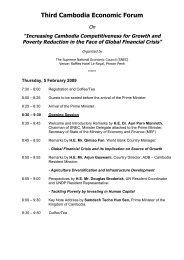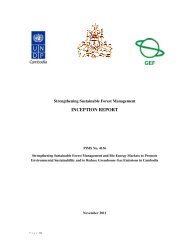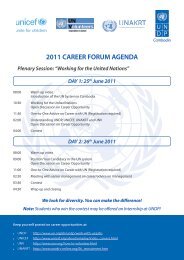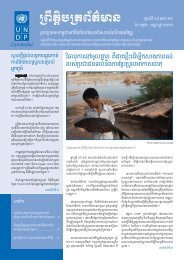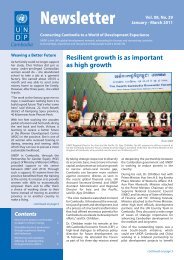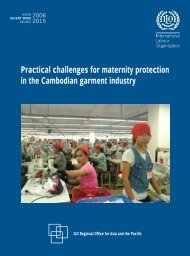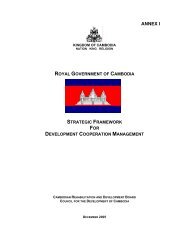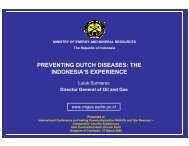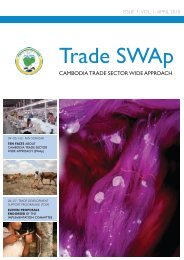UN Analysis Final.pdf - United Nations in Cambodia
UN Analysis Final.pdf - United Nations in Cambodia
UN Analysis Final.pdf - United Nations in Cambodia
You also want an ePaper? Increase the reach of your titles
YUMPU automatically turns print PDFs into web optimized ePapers that Google loves.
ANNEX 4-4<br />
KEY POLICY, STRATEGY AND TARGETS FOR EDUCATION SECTOR<br />
KEY POLICIES, STRATEGIES AND TARGETS<br />
Equitable Access to Education Services<br />
• Expand access to ECE (early childhood education) programmes for 5 year olds targeted on those communes with low new admission<br />
rates and high repetition rates <strong>in</strong> primary schools.<br />
• Ensure entry of all 6 year olds <strong>in</strong>to primary school by perform<strong>in</strong>g regular population census and by issu<strong>in</strong>g a decree and guidel<strong>in</strong>es for<br />
6 years as age of entry to primary school.<br />
• Reduce parental costs barriers (such as <strong>in</strong>formal payments) by <strong>in</strong>creas<strong>in</strong>g operational budgets for schools and teachers’ salaries.<br />
• Enable Greater Private/Community <strong>in</strong>volvement <strong>in</strong> all stages of school<strong>in</strong>g <strong>in</strong> order to <strong>in</strong>crease understand<strong>in</strong>g of importance of education<br />
as well as achiev<strong>in</strong>g greater transparency and accountability <strong>in</strong> the structures.<br />
• Cont<strong>in</strong>ued provision of new schools or additional facilities to <strong>in</strong>complete primary schools as well as locat<strong>in</strong>g school facilities closer to<br />
home thus reduc<strong>in</strong>g direct and opportunity costs for families.<br />
• Increase the number of scholarships for youth from poor families, especially girls.<br />
• Expand public-NGO community partnerships <strong>in</strong> non-formal education to promote education <strong>in</strong> border, remote and disadvantaged<br />
areas to response to labour market.<br />
Increas<strong>in</strong>g quality and efficiency of the education services<br />
• Improve the quality of teach<strong>in</strong>g and learn<strong>in</strong>g through nationwide implementation of child-friendly school and school read<strong>in</strong>ess<br />
programs.<br />
• Increase the schools’ and tra<strong>in</strong><strong>in</strong>g <strong>in</strong>stitutions’ operational autonomy and accountability regard<strong>in</strong>g operational budgets and<br />
decisions on programs by establish<strong>in</strong>g new f<strong>in</strong>ancial plann<strong>in</strong>g and accountability mechanisms for school operat<strong>in</strong>g budgets.<br />
• Strengthen<strong>in</strong>g teach<strong>in</strong>g and learn<strong>in</strong>g quality to ensure primary and secondary teachers with pedagogy and ICT (Information<br />
Communication Technology) awareness.<br />
• Implement the m<strong>in</strong>imum standards of student achievement for grades 3, 6 and 9 nationwide, assure a shared understand<strong>in</strong>g of<br />
m<strong>in</strong>imum standards amongst teachers, parents and other stakeholders and follow up on the results of the tests <strong>in</strong> the nationwide<br />
school report cards.<br />
• Increase transparency and improve performance monitor<strong>in</strong>g and accountability of teachers, schools and post-secondary <strong>in</strong>stitutions<br />
by dissem<strong>in</strong>at<strong>in</strong>g the result of students’ achievements to the public by promot<strong>in</strong>g the education authorities at all levels <strong>in</strong>clud<strong>in</strong>g the<br />
education <strong>in</strong>spectors.<br />
Institutional Development and Capacity Build<strong>in</strong>g for Decentralization<br />
• Provide a clearly def<strong>in</strong>ed legislative, regulatory framework to the sector and the sub-sectors through the adoption of the Education<br />
Law by end of 2006.<br />
• Improved predictability for Medium Term F<strong>in</strong>ancial Plann<strong>in</strong>g and decentralized management and improved Governance and<br />
Regulatory Systems by <strong>in</strong>creas<strong>in</strong>g transparency and accountability of resources, <strong>in</strong>clud<strong>in</strong>g external assistance.<br />
• Strengthen<strong>in</strong>g education system performance monitor<strong>in</strong>g, personnel management, monitor<strong>in</strong>g systems and impact systems,<br />
<strong>in</strong>clud<strong>in</strong>g ESP-ESSP review processes.<br />
• Strengthen<strong>in</strong>g Central, Prov<strong>in</strong>cial and District F<strong>in</strong>ancial Monitor<strong>in</strong>g Systems by <strong>in</strong>creased access to tra<strong>in</strong><strong>in</strong>g for Budget Management<br />
Centers (BMCs).<br />
• Assur<strong>in</strong>g that all designated Budget Management Centers become operational and effective, and that District and School/<br />
Institutional Management Systems are enhanced to ensure quality education.<br />
• Expand public-NGO community partnerships <strong>in</strong> non-formal education <strong>in</strong> border, remote and disadvantaged areas to promote life<br />
skills, vocational tra<strong>in</strong><strong>in</strong>g and professional skills to satisfy the labour market demand.<br />
Source: Ibid, pp. 11-13<br />
180 Situation <strong>Analysis</strong> of Youth <strong>in</strong> <strong>Cambodia</strong>




